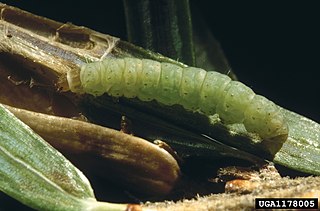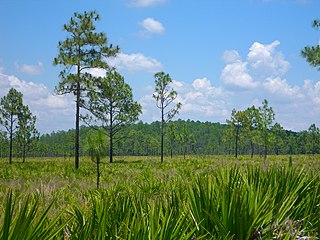
Taxodium is a genus of one to three species of extremely flood-tolerant conifers in the cypress family, Cupressaceae. The name is derived from the Latin word taxus, meaning "yew", and the Greek word εἶδος (eidos), meaning "similar to." Within the family, Taxodium is most closely related to Chinese swamp cypress and sugi.
Cypress is a common name for various coniferous trees or shrubs from the Cupressus genus of the Cupressaceae family, typically found in warm-temperate and subtropical regions of Asia, Europe, and North America.
Corkscrew Swamp Sanctuary is a National Audubon Society sanctuary located in southwest Florida, north of Naples, Florida and east of Bonita Springs, in the United States. The sanctuary was established to protect one of the largest remaining stands of bald cypress and pond cypress in North America from extensive logging that was ongoing throughout the 1940s and 1950s.

The geometer moths are moths belonging to the family Geometridae of the insect order Lepidoptera, the moths and butterflies. Their scientific name derives from the Ancient Greek geo γεω, and metron μέτρον "measure" in reference to the way their larvae, or inchworms, appear to measure the earth as they move along in a looping fashion. Geometridae is a very large family, containing around 23,000 described species; over 1400 species from six subfamilies are indigenous to North America alone. A well-known member is the peppered moth, Biston betularia, which has been the subject of numerous studies in population genetics. Several other geometer moths are notorious pests.

Taxodium ascendens, also known as pond cypress, is a deciduous conifer of the genus Taxodium, native to North America. Many botanists treat it as a variety of bald cypress, Taxodium distichum rather than as a distinct species, but it differs in habitat, occurring mainly in still blackwater rivers, ponds and swamps without silt-rich flood deposits. It predominates in cypress dome habitats.

Taxodium mucronatum, commonly known as Montezuma bald cypress, Montezuma cypress, or ahuehuete, is a species of Taxodium that is primarily native to Mexico and Guatemala, with a few populations in the southwestern United States. Ahuehuete is derived from the Nahuatl name for the tree, āhuēhuētl, which means "upright drum in water" or "old man of the water."

Taxodium distichum is a deciduous conifer in the family Cupressaceae. It is native to the southeastern United States. Hardy and tough, this tree adapts to a wide range of soil types, whether wet, salty, dry, or swampy. It is noted for the russet-red fall color of its lacy needles.

Glyptostrobus pensilis, known in Chinese as 水松, and also Chinese swamp cypress, is an endangered conifer, and the sole living species in the genus Glyptostrobus.

Tyler Arboretum is a nonprofit arboretum located at 515 Painter Road, Middletown Township, Delaware County, Pennsylvania. It is open daily except for major holidays; an admission fee is charged to non-members.
Axe Lake Swamp State Nature Preserve is a 458-acre (1.9 km2) nature reserve located near Barlow, Kentucky in Ballard County in an area known locally as "the Barlow bottoms", a wetland created by periodic flooding along the mouth of the Ohio River. Originally, Axe Lake consisted of 146 acres (0.6 km2) of the main lake and about 120 lots on the dryer portions of the property. These lots, the gate and an access road were maintained by a member/share-holder organization which agreed to the lake's dedication as a nature reserve on February 20, 1991. An additional 312 acres (1.3 km2) was dedicated on December 11, 2001.

The beech blight aphid is a small insect in the order Hemiptera that feed primarily on the sap of American beech trees. The aphids form dense colonies on small branches and the undersides of leaves. A secondary host, based on their geographic location, is the roots of the bald cypress (Taxodium distichum), where some aphids alternate between hosts and others remain with Taxodium distichum year-round.

The genus Crambus includes around 155 species of moths in the family Crambidae, distributed globally. The adult stages are called crambid snout moths, while the larvae of Crambus and the related genus Herpetogramma are the sod webworms, which can damage grasses.

Anacamptodes is a genus of moths in the family Geometridae erected by James Halliday McDunnough in 1920. There are around 40 species within the genus, although a number have been reassigned to the genus Iridopsis.

Iridopsis is a genus of moths in the family Geometridae first described by Warren in 1894.

Lithophane abita is a moth of the family Noctuidae. It is found in Alabama, Florida, Georgia, Louisiana, Maryland, Mississippi and North Carolina.

The green hemlock needleminer, hemlock leaf miner or baldcypress webworm is a moth of the family Gelechiidae. It is found in the eastern parts of the United States, as well as eastern Canada.

A cypress dome is a type of freshwater forested wetland, or a swamp, found in the southeastern part of the United States. They are dominated by the Taxodium spp., either the bald cypress, or pond cypress. The name comes from the dome-like shape of treetops, formed by smaller trees growing on the edge where the water is shallow while taller trees grow at the center in deeper water. They usually appear as circular, but if the center is too deep, they form a “doughnut” shape when viewed from above. Cypress domes are characteristically small compared to other swamps, however they can occur at a range of sizes, dependent on the depth.

A strand swamp or strand is a type of swamp in Florida that forms a linear drainage channel on flatlands. A forested wetland ecological habitat, strands occur on land areas with high water tables where the lack of slope prevents stream formation. Strands are more linear than the cypress dome swamps that form in more rounded depressions and are fairly similar to floodplain swamps that form further north along streams and rivers.

Florida swamps include a variety of wetland habitats. Because of its high water table, substantial rainfall, and often flat geography, the U.S. state of Florida has a proliferation of swamp areas, some of them unique to the state.
The southern coastal plain blackwater river floodplain forest is a forest system found in Alabama, Mississippi, Florida, and Georgia. These forests occur in the drainages of blackwater rivers and streams whose dark water is caused by high levels of tannins, particulates, and other materials accumulated as they drain through swamps and marshes. The water has little mineral sediment and few suspended clay particles.

























